北师大版(2019)选择性必修 第三册Unit 9 Human Biology Lesson3 Epidemics Explained 课件(共19张PPT)
文档属性
| 名称 | 北师大版(2019)选择性必修 第三册Unit 9 Human Biology Lesson3 Epidemics Explained 课件(共19张PPT) | 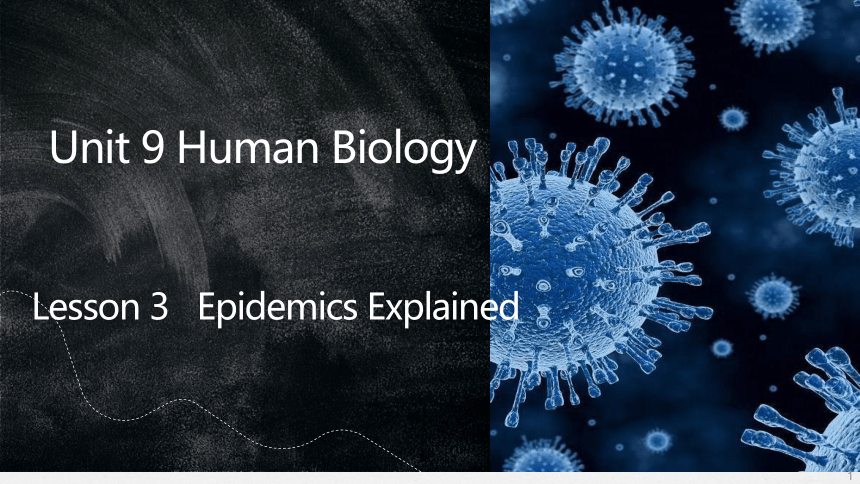 | |
| 格式 | pptx | ||
| 文件大小 | 9.9MB | ||
| 资源类型 | 教案 | ||
| 版本资源 | 北师大版(2019) | ||
| 科目 | 英语 | ||
| 更新时间 | 2024-05-14 14:51:17 | ||
图片预览

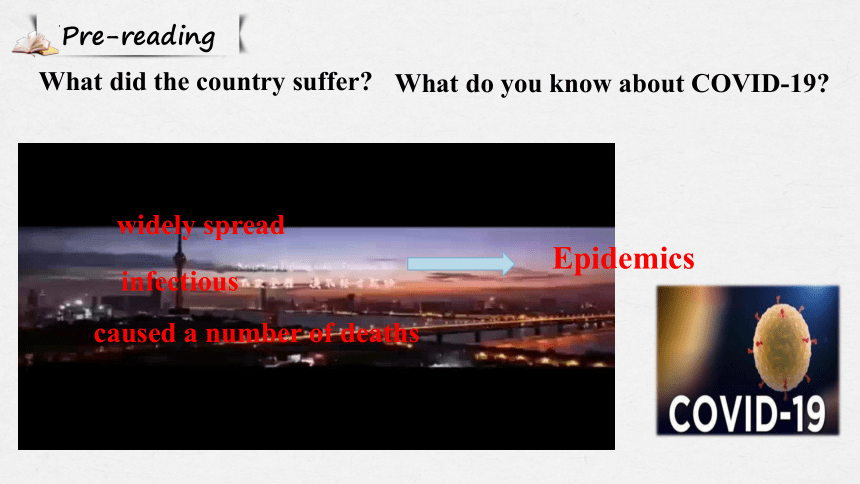
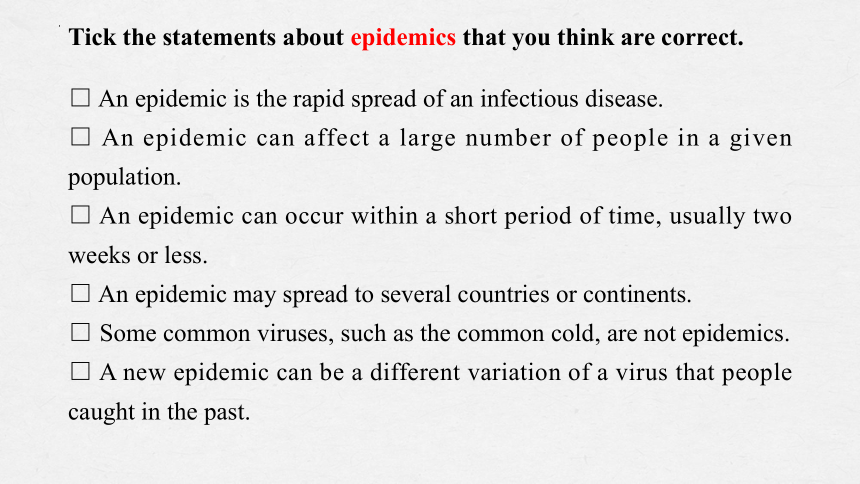
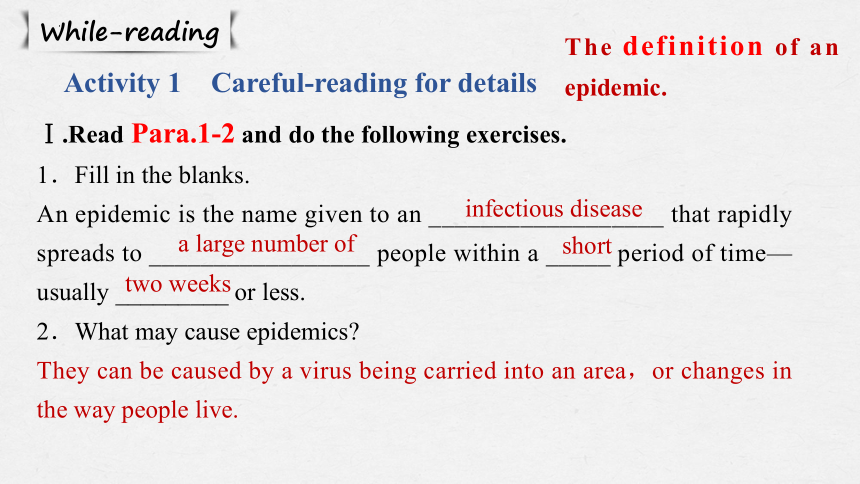
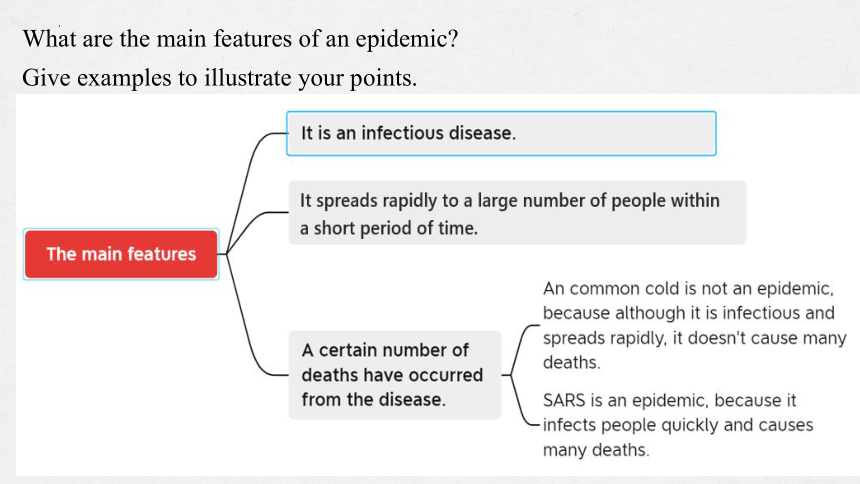
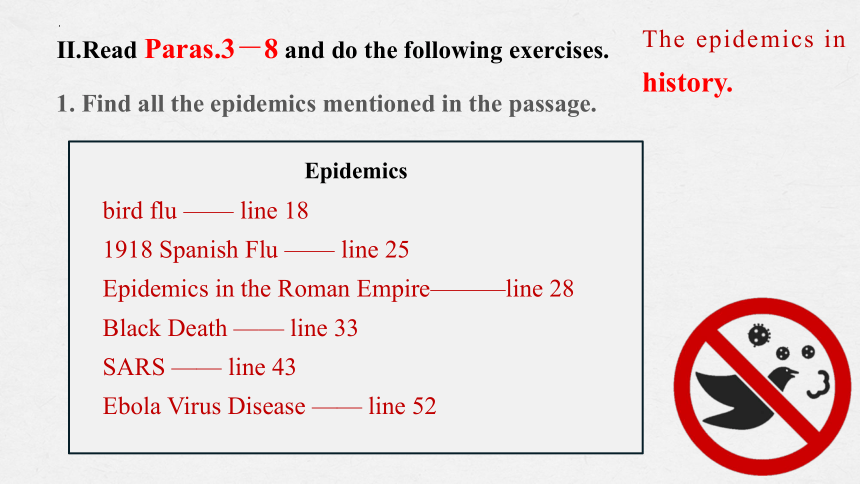
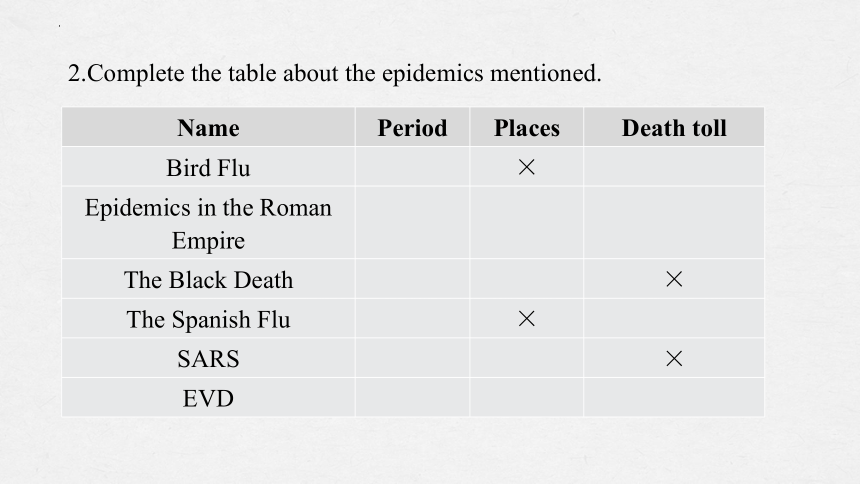
文档简介
(共19张PPT)
1
Unit 9 Human Biology
Lesson 3 Epidemics Explained
Pre-reading
What did the country suffer
What do you know about COVID-19
widely spread
infectious
caused a number of deaths
Epidemics
Tick the statements about epidemics that you think are correct.
□ An epidemic is the rapid spread of an infectious disease.
□ An epidemic can affect a large number of people in a given population.
□ An epidemic can occur within a short period of time, usually two weeks or less.
□ An epidemic may spread to several countries or continents.
□ Some common viruses, such as the common cold, are not epidemics.
□ A new epidemic can be a different variation of a virus that people caught in the past.
Ⅰ.Read Para.1-2 and do the following exercises.
1.Fill in the blanks.
An epidemic is the name given to an __________________ that rapidly spreads to _________________ people within a _____ period of time—usually _________ or less.
2.What may cause epidemics
They can be caused by a virus being carried into an area,or changes in the way people live.
infectious disease
a large number of
short
two weeks
Activity 1 Careful-reading for details
While-reading
The definition of an epidemic.
What are the main features of an epidemic
Give examples to illustrate your points.
Ⅱ.Read Paras.3-8 and do the following exercises.
1. Find all the epidemics mentioned in the passage.
Epidemics
bird flu —— line 18
1918 Spanish Flu —— line 25
Epidemics in the Roman Empire———line 28
Black Death —— line 33
SARS —— line 43
Ebola Virus Disease —— line 52
The epidemics in history.
2.Complete the table about the epidemics mentioned.
Name Period Places Death toll
Bird Flu ×
Epidemics in the Roman Empire
The Black Death ×
The Spanish Flu ×
SARS ×
EVD
Name Period Places Death toll
Bird Flu ×
Epidemics in the Roman Empire
The Black Death ×
The Spanish Flu ×
SARS ×
EVD
since 1997
more than a hundred lives
500-550 CE
Rome
half the population
1330s
Asia and Europe
1918—the end of WWⅠ
2002-2003
China, Canada, Vietnam and Singapore
50 million people
2013-2016
West Africa
more than
11,310 death
Details about COVID-19
Infected person: More than 400 million
Death: More than 6 million
Related countries: countries and regions all over the world
Time: began in 2020.
9
Ⅲ.Read Para.9 and do the following exercises.
1.What should different countries do to prevent outbreaks of epidemics in the future Why
They should work together because teamwork among nations across the globe can save lives.
2.What can we individuals do to protect us from epidemics such as COVID-19
Wear a mask
Wash your hands
Get vaccinated
Open the window
and ventilate (通风)
the rooms
Don’t stay up late and
exercise regularly
Ⅳ.Read the whole passage again and do the following exercises.
1.What is the author’s attitude towards man’s struggle against epidemics
A.Positive. B.Doubtful.
C.Critical. D.Uninterested.
√
√
2. What will the author write next
A.How to do systematic medical research on epidemics.
B.How to cooperate to find the cures.
C.Other epidemics in the world.
D.Solutions to epidemics.
a. citing ideas from experts or authorities
b. giving examples
c. using data
d. giving definition
e. using comparison and contrast
3.What methods does the author use to develop the passage
Post-reading
1.What does the title mean to you What does the writer want to convey in the passage
Activity 1 Discussion
◆ The title means that the passage will explain questions about
epidemics.
◆ The author wants to convey the information that we are always
on our way to find an explanation to epidemics so as to find
cure. It also implies that epidemics occurred naturally and
inevitably(不可避免地). We can only explain it, and cannot
prevent it or stop it completely now.
Epidemics
definition of epidemics
baseline number of deaths of epidemics(criteria)
examples of epidemics
(history)
when epidemics started
when it ended
work together to fight epidemics
(solutions)
2.Use a diagram to demonstrate in a logical way how the aspects of information are organised.
An epidemic is the rapid spread of an 1.__________(infect) disease over a short period of time,2._______(cause) a large number of deaths,the number of which differs for different diseases.
infectious
causing
Activity 2 Summary
Professor Jim Smith studied the history of epidemics 3._________(create) a more positive future.One of the 4.________(early) epidemics on record took place in Rome as early as 500 to 550 CE,5._____ killed half of the population in that particular area.The same epidemic called “The Black Death” returned in 6.____ 1330s in Asia and spread quickly to Europe.Some hundred years later,the Great Flu Epidemic broke 7.___ in 1918,also known as the Spanish Flu,killing 50 million people.This was considered the most severe epidemic in human history.The 1997 bird flu which claimed over 100 lives was an 8.__________(adapt) of the Great Flu of 1918.
to create
earliest
which
the
out
adaptation
At the start of the 21st century there were two major epidemics—SARS and EVD.The more recently 9.__________(discover) SARS disease infected about 8,000 people.According to official records EVD has killed more than 11,310 people in West Africa alone.
10.________(global),researchers are coming together to try to identify the causes and help to find effective treatments for epidemics.
discovered
Globally
Search online and find some information about epidemics in the world.
Homework
Thanks for listening !
1
Unit 9 Human Biology
Lesson 3 Epidemics Explained
Pre-reading
What did the country suffer
What do you know about COVID-19
widely spread
infectious
caused a number of deaths
Epidemics
Tick the statements about epidemics that you think are correct.
□ An epidemic is the rapid spread of an infectious disease.
□ An epidemic can affect a large number of people in a given population.
□ An epidemic can occur within a short period of time, usually two weeks or less.
□ An epidemic may spread to several countries or continents.
□ Some common viruses, such as the common cold, are not epidemics.
□ A new epidemic can be a different variation of a virus that people caught in the past.
Ⅰ.Read Para.1-2 and do the following exercises.
1.Fill in the blanks.
An epidemic is the name given to an __________________ that rapidly spreads to _________________ people within a _____ period of time—usually _________ or less.
2.What may cause epidemics
They can be caused by a virus being carried into an area,or changes in the way people live.
infectious disease
a large number of
short
two weeks
Activity 1 Careful-reading for details
While-reading
The definition of an epidemic.
What are the main features of an epidemic
Give examples to illustrate your points.
Ⅱ.Read Paras.3-8 and do the following exercises.
1. Find all the epidemics mentioned in the passage.
Epidemics
bird flu —— line 18
1918 Spanish Flu —— line 25
Epidemics in the Roman Empire———line 28
Black Death —— line 33
SARS —— line 43
Ebola Virus Disease —— line 52
The epidemics in history.
2.Complete the table about the epidemics mentioned.
Name Period Places Death toll
Bird Flu ×
Epidemics in the Roman Empire
The Black Death ×
The Spanish Flu ×
SARS ×
EVD
Name Period Places Death toll
Bird Flu ×
Epidemics in the Roman Empire
The Black Death ×
The Spanish Flu ×
SARS ×
EVD
since 1997
more than a hundred lives
500-550 CE
Rome
half the population
1330s
Asia and Europe
1918—the end of WWⅠ
2002-2003
China, Canada, Vietnam and Singapore
50 million people
2013-2016
West Africa
more than
11,310 death
Details about COVID-19
Infected person: More than 400 million
Death: More than 6 million
Related countries: countries and regions all over the world
Time: began in 2020.
9
Ⅲ.Read Para.9 and do the following exercises.
1.What should different countries do to prevent outbreaks of epidemics in the future Why
They should work together because teamwork among nations across the globe can save lives.
2.What can we individuals do to protect us from epidemics such as COVID-19
Wear a mask
Wash your hands
Get vaccinated
Open the window
and ventilate (通风)
the rooms
Don’t stay up late and
exercise regularly
Ⅳ.Read the whole passage again and do the following exercises.
1.What is the author’s attitude towards man’s struggle against epidemics
A.Positive. B.Doubtful.
C.Critical. D.Uninterested.
√
√
2. What will the author write next
A.How to do systematic medical research on epidemics.
B.How to cooperate to find the cures.
C.Other epidemics in the world.
D.Solutions to epidemics.
a. citing ideas from experts or authorities
b. giving examples
c. using data
d. giving definition
e. using comparison and contrast
3.What methods does the author use to develop the passage
Post-reading
1.What does the title mean to you What does the writer want to convey in the passage
Activity 1 Discussion
◆ The title means that the passage will explain questions about
epidemics.
◆ The author wants to convey the information that we are always
on our way to find an explanation to epidemics so as to find
cure. It also implies that epidemics occurred naturally and
inevitably(不可避免地). We can only explain it, and cannot
prevent it or stop it completely now.
Epidemics
definition of epidemics
baseline number of deaths of epidemics(criteria)
examples of epidemics
(history)
when epidemics started
when it ended
work together to fight epidemics
(solutions)
2.Use a diagram to demonstrate in a logical way how the aspects of information are organised.
An epidemic is the rapid spread of an 1.__________(infect) disease over a short period of time,2._______(cause) a large number of deaths,the number of which differs for different diseases.
infectious
causing
Activity 2 Summary
Professor Jim Smith studied the history of epidemics 3._________(create) a more positive future.One of the 4.________(early) epidemics on record took place in Rome as early as 500 to 550 CE,5._____ killed half of the population in that particular area.The same epidemic called “The Black Death” returned in 6.____ 1330s in Asia and spread quickly to Europe.Some hundred years later,the Great Flu Epidemic broke 7.___ in 1918,also known as the Spanish Flu,killing 50 million people.This was considered the most severe epidemic in human history.The 1997 bird flu which claimed over 100 lives was an 8.__________(adapt) of the Great Flu of 1918.
to create
earliest
which
the
out
adaptation
At the start of the 21st century there were two major epidemics—SARS and EVD.The more recently 9.__________(discover) SARS disease infected about 8,000 people.According to official records EVD has killed more than 11,310 people in West Africa alone.
10.________(global),researchers are coming together to try to identify the causes and help to find effective treatments for epidemics.
discovered
Globally
Search online and find some information about epidemics in the world.
Homework
Thanks for listening !
